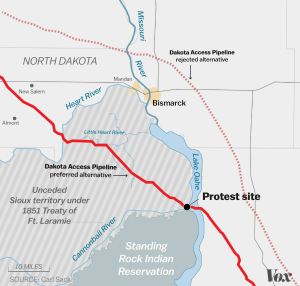For over a year, national media sources have covered the controversial Dakota Pipeline project, representing perspectives ranging from concerned environmental activists to corporate capitalists. Despite this buzz, media sources have failed to give sufficient attention to the Sioux Tribe’s perspective on the Pipeline, which, if acknowledged, poses a significant challenge to the pipeline. The Sioux’s perspective can be understood through the concept of lived religion which explains that the sacred is intertwined with everyday life (Orsi, 2003). If this concept were applied to the Sioux, people would understand and appreciate that the land the pipeline crosses is sacred and intertwined with the Sioux’s everyday life. As such, building on that land threatens the Sioux’s way of life.
Why does the Sioux regard this land as sacred?
Monuments on this land hold religious and historical value to the Sioux. For example, a stone statue that stands in the area that the pipeline is set to destroy represents an area visited by members of the tribe during spiritual prayer (Bailey, 2016). Canon Ball River Drainage holds sacred status as well. As Peter Nabokov, a UCLA professor of American Indian Students, has noted, “warring bands of enemies never created conflict with each other as a spiritual presence was there (Bailey, 2016).” The land, itself, is also viewed as intrinsically sacred. Stephen Pevar, an attorney with the ACLU, has explained that land is “critical…to Native spirituality” and that Native Americans cultivate a sacred bond with the land.
The sacred value that Sioux subscribe to the land is not a distant and obscure concept. In addition to valuing the land for being sacred, the Sioux value the land for its everyday uses. The Sioux use the land for hunting and fishing and as a burial ground and water supply (Healy, 2016). This use and value of the land reflects the concept of lived religion which suggests religion and the sacred are part of, “the way human do other necessary and important things (Orsi, 2003).” Lived religion reveals that this land simultaneously has sacred qualities and is crucial to the Sioux’s everyday life.
The Sioux’s claim to the land
The Sioux place importance on this land because they believe that the land belongs to the tribe. In 1868, the Fort Laramie Treaty established the Great Sioux Reservation. In 1877, Congress removed major areas of land from the reservation without the required consent of three fourths of the tribe. By removing this land, Congress separated Standing Rock Reservation from the Great Sioux Reservation. The proposed pipeline would cross this same area of land that Congress removed from the reservation.

Map of the land that the Dakota Pipeline is proposed to cross.
The Proposed Dakota Pipeline
Once it’s completed, the Dakota Pipeline will cross 1,172 miles, cost 3.7 billion dollars to build, and transport 570,000 barrels of crude oil each day (Monet, 2016). Energy Transfer Partners LLC owns the pipeline, and on March 11, 2016, the Iowa Utilities board unanimously approved the plans to build it (Miller, 2016). Pipeline supporters — who include corporate capitalists— see the pipeline as profitable. They argue that the pipeline will aid in transportation of crude oil, create thousands of construction jobs, and boost the American steel industry (Bailey, 2016).
Pipeline opponents – who include vocal and well-publicized environmental activists — counter these claims with arguments that the pipeline will contaminate drinking water, promote fossil fuels, and infringe on Native American sacred land (Bailey, 2016). Environmental activists have gathered in camps surrounding the pipeline since April 1, 2016 (Bailey, 2016). Protestors, chant, “Mni Wiconi”– Water is Life – claiming that the pipeline has detrimental consequences to the clean water in the area (Monet, 2016).

Environmental activists and Sioux protesting to “protect” water.
The Sioux’s perspective of the pipeline, seen through the context of lived religion, is woefully under-appreciated. The arguments of the corporate capitalists and environmental activists have overshadowed the Sioux perspective. The pipeline would cause harm to the Sioux – by disturbing land that is sacred and critical to their everyday life. No one would think about building a pipeline through the National Cathedral in Washington, D.C. or St. Patrick’s Cathedral in New York City. This pipeline, through lived religion, is just as sacred and should be just as untouchable.
I didn’t know the religious incentives behind the Sioux Tribe’s protest against the Dakota Pipeline and my lack of knowledge on that part of the issue demonstrates how important posts like yours are. The Pipeline is not just a political and environmental issue, but it is also a social issue as the Sioux’s culture and lifestyle is in jeopardy. I think your last paragraph about how no one would build a pipeline through the National or St. Patrick’s Cathedral is especially interesting and very true. The destruction of a structure that is meaningful to a larger, more economically and politically powerful religion would cause national outrage. This shows that the Dakota Pipeline is an issue fueled by religious and ethnic prejudice. There is a general misunderstanding of religions different from ones own in the US and the world which fuels unawareness and ignorance of other minority cultures.
LikeLike
I think a huge part of issue for me comes from the fact that if this was Christian sacred land this never would have happened. In fact near Thompson, Pennsylvania an entire highway has been recently moved because the Church of the Latter Day Saints has a religious site that was too close to the original highway. A highway does not cause any of the problems that could come from the pipeline and people don’t live where the highway was moved from but it was done quickly and without protest.
LikeLike
I was against the building of this pipeline for all the reasons in the world but never did it occur to me that lived religion and spirituality was a very huge factor. This is very interesting perspective that should be the subject of conversations out there. I am just curious why this is not the case. Is this the capitalist media’s intention not to cover and publicize it or it is the general public’s lack of interest in hearing the Sioux’s perspective?
LikeLike